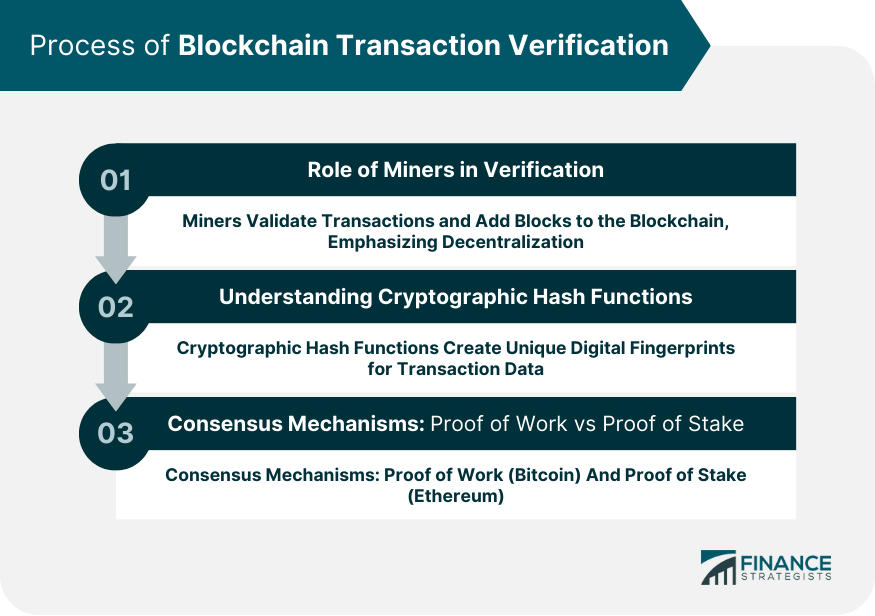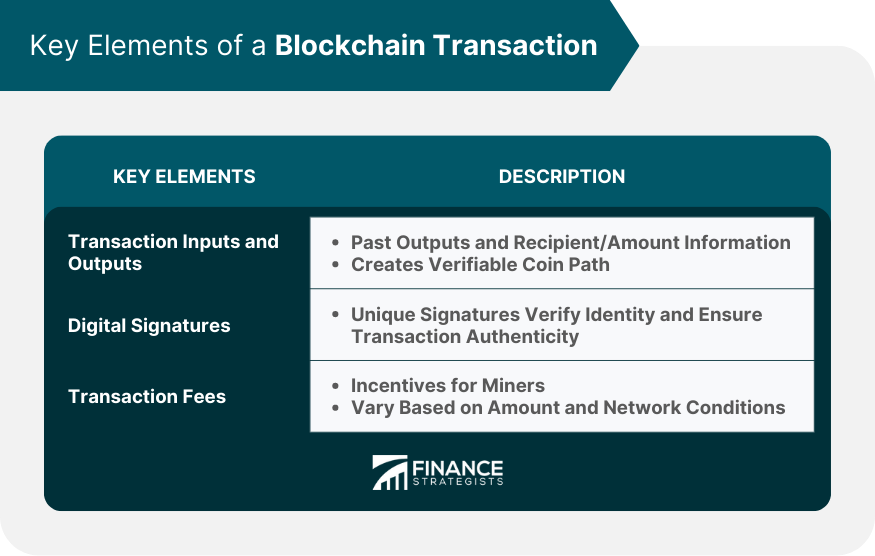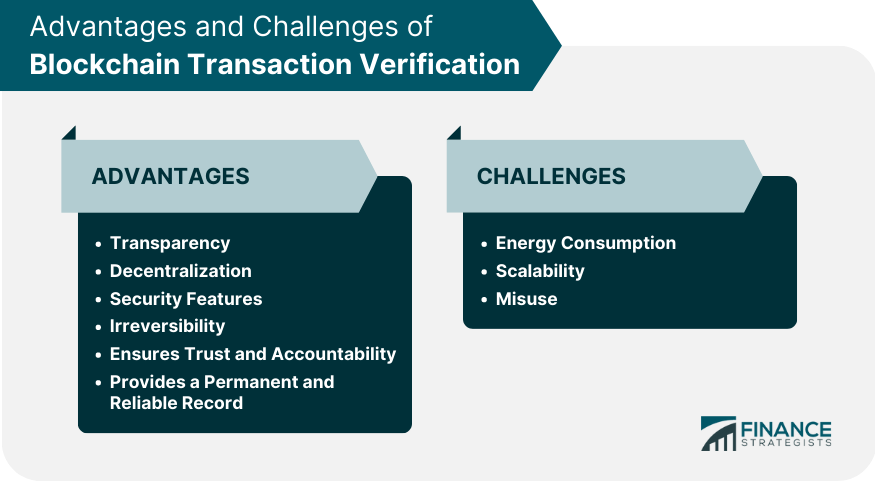Blockchain transaction verification stands as a fundamental process intrinsic to the functioning of blockchain technology. It facilitates the validation and addition of transactions to the blockchain ledger - a form of a digital and distributed ledger. Grasping the essence of this process is a step toward deciphering the multifaceted potential of blockchain technology. Within the labyrinthine architecture of the blockchain network, a certain group, aptly called "miners," is entrusted with the task of validating transactions. The name "miners" is a nod to the process akin to mining gold. They exert computational power to solve intricate mathematical problems. The reward for their strenuous effort is the privilege of adding the next block of verified transactions to the ever-growing blockchain. It's a race, where the first to solve the problem reaps the reward. This crucial role underscores the decentralized characteristic of blockchain technology. Cryptographic hash functions play a significant role in the verification process. These mathematical operations intake data of any size and return a fixed size of output data. Each transaction data, when processed through the hash function, produces a unique string of characters or a hash. This hash acts as a digital fingerprint, each unique and unmistakably representative of the corresponding transaction data. Consensus mechanisms form the framework through which blockchain networks agree on the current state of the blockchain. The two most widely used consensus mechanisms are Proof of Work (PoW) and Proof of Stake (PoS). In the PoW system, which Bitcoin employs, miners compete to solve complex mathematical problems. The first to provide a solution has the honor of adding the new block to the chain. On the other hand, the PoS system, employed by Ethereum, assigns mining power based on the proportion of coins that a miner holds. These systems ensure fairness and maintain the decentralized ethos of the blockchain. A blockchain transaction can be broken down into its building blocks: inputs and outputs. Inputs are references to the outputs of past transactions. The outputs specify the recipient's address and the amount to be transferred. If a transaction output is used as an input in a subsequent transaction, it becomes spent and cannot be used again. The chain of inputs and outputs creates a verifiable path for each coin. Blockchain transactions feature a key security component known as digital signatures. These signatures are generated uniquely for each transaction through a process involving the sender's private key. The signatures verify the sender's identity and help to ensure the authenticity of the transaction, safeguarding against fraudulent activity. Transaction fees serve as incentives for miners. These fees are usually a small fraction of the transacted amount, which encourages miners to include the transactions in the block they are currently mining. Transaction fees are not fixed; they fluctuate based on the data size of the transaction and the level of congestion on the network. As a general rule, transactions with higher fees get processed faster. Blockchain transaction verification brings about a high level of transparency. As all transactions are visible to every participant in the network, the blockchain provides a level of traceability not seen in traditional financial systems. This visibility is a robust deterrent to fraud and fosters a sense of trust and accountability among network participants. Blockchain verification eliminates the need for a central authority, such as a bank or government, to validate transactions. This decentralization shifts the power from a centralized entity to all the participants in the network, providing a democratic, distributed system of control. The design of blockchain transaction verification inherently enhances security. The cryptographic hash functions and digital signatures provide a strong defense against tampering. The design of the blockchain itself, where altering a block requires changes to all subsequent blocks, presents a near-impossible task due to the sheer computational power required. A characteristic feature of blockchain transactions is their irreversibility. Once a transaction has been verified and added to the blockchain, it is impossible to alter or erase. This provides a reliable, permanent record of transactions, a feature of particular value in financial and legal applications. A major drawback of Proof of Work (PoW) blockchain is the enormous energy consumption. The computational power needed to solve the mathematical problems requires significant electrical energy, raising concerns about the environmental impact. As the number of transactions surges, the time required to verify and add them to the blockchain can become a limiting factor. This challenge is especially relevant in popular blockchains like Bitcoin, where the block size is limited and cannot accommodate an increasing number of transactions. The anonymity provided by blockchain transactions can be exploited for illegal activities, such as money laundering. Additionally, the irreversible nature of blockchain transactions can be manipulated to carry out fraudulent activities. In response to the challenges of energy consumption and scalability, new consensus algorithms are being developed. These new models aim to retain the benefits of blockchain technology while addressing its limitations. Algorithms like Proof of Stake (PoS) and Delegated Proof of Stake are emerging as potential alternatives to Proof of Work, offering solutions that are more energy-efficient and scalable. The advent of quantum computing represents both an opportunity and a threat for blockchain technology. Quantum computers, with their superior computational abilities, could potentially break current cryptographic defenses, posing a significant security risk. On the other hand, the advent of quantum computing could spur the development of new, more efficient consensus algorithms. Interoperability, or the ability of different blockchains to communicate and transact with each other, represents another potential solution to the scalability issue. Cross-chain transactions could distribute transactions across multiple blockchains, reducing the load on any single chain. However, the technology to enable seamless cross-chain transactions is still in its infancy, with many technical hurdles yet to be overcome. Blockchain transaction verification, with its multifaceted attributes, plays an instrumental role in enabling the core benefits of blockchain technology: transparency, security, and decentralization. Despite the challenges it faces, such as energy consumption, scalability issues, and potential for misuse, its immense potential cannot be overlooked. Innovations in consensus algorithms, advances in quantum computing, and the exploration of cross-chain transactions could provide solutions to current challenges. As such, engagement with and understanding of blockchain transaction verification remain crucial as we move toward a more decentralized financial future.What Is Blockchain Transaction Verification?
Process of Blockchain Transaction Verification
Role of Miners in Verification
Understanding Cryptographic Hash Functions
Consensus Mechanisms: Proof of Work vs Proof of Stake

Key Elements of a Blockchain Transaction
Transaction Inputs and Outputs
Digital Signatures
Transaction Fees

Benefits of Blockchain Transaction Verification
Ensuring Transparency and Traceability
Decentralization: Power to the People
Security Features: How Blockchain Transaction Verification Enhances Safety
Irreversibility: The Finality of Completed Transactions
Challenges of Blockchain Transaction Verification
Energy Consumption: An Environmental Perspective
Scalability: Overcoming Transaction Throughput Limits
Misuse: Fraud and Illicit Activities

Coping Mechanisms and Solutions for Blockchain Transaction Verification
Evolution of Consensus Algorithms
Threats and Opportunities From Quantum Computing
Addressing Interoperability: The Rise of Cross-Chain Transactions
Conclusion
Blockchain Transaction Verification FAQs
Blockchain transaction verification ensures the integrity and authenticity of transactions by validating and adding them to the blockchain ledger.
Blockchain transaction verification enables transparency by making all transactions visible to network participants, creating a highly transparent and traceable record.
Benefits of blockchain transaction verification include transparency, security, decentralization, and the creation of permanent and reliable transaction records.
Challenges of blockchain transaction verification include energy consumption, scalability issues, and the potential for misuse or fraudulent activities.
Blockchain transaction verification enhances security through the use of cryptographic hash functions, digital signatures, and the immutability of verified transactions, providing a strong defense against tampering and fraud.
True Tamplin is a published author, public speaker, CEO of UpDigital, and founder of Finance Strategists.
True is a Certified Educator in Personal Finance (CEPF®), author of The Handy Financial Ratios Guide, a member of the Society for Advancing Business Editing and Writing, contributes to his financial education site, Finance Strategists, and has spoken to various financial communities such as the CFA Institute, as well as university students like his Alma mater, Biola University, where he received a bachelor of science in business and data analytics.
To learn more about True, visit his personal website or view his author profiles on Amazon, Nasdaq and Forbes.















